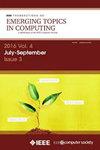What, When, Where to Compute-in-Memory for Efficient Matrix Multiplication During Machine Learning Inference
IF 5.4
2区 计算机科学
Q1 COMPUTER SCIENCE, INFORMATION SYSTEMS
IEEE Transactions on Emerging Topics in Computing
Pub Date : 2025-06-05
DOI:10.1109/TETC.2025.3574508
引用次数: 0
Abstract
Matrix multiplication is the dominant computation during Machine Learning (ML) inference. To efficiently perform such multiplication operations, Compute-in-memory (CiM) paradigms have emerged as a highly energy efficient solution. However, integrating compute in memory poses key questions, such as 1) What type of CiM to use: Given a multitude of CiM design characteristics, determining their suitability from architecture perspective is needed. 2) When to use CiM: ML inference includes workloads with a variety of memory and compute requirements, making it difficult to identify when CiM is more beneficial than standard processing cores. 3) Where to integrate CiM: Each memory level has different bandwidth and capacity, creating different data reuse opportunities for CiM integration. To answer such questions regarding on-chip CiM integration for accelerating ML workloads, we use an analytical architecture-evaluation methodology with tailored mapping algorithm. The mapping algorithm aims to achieve highest weight reuse and reduced data movements for a given CiM prototype and workload. Our analysis considers the integration of CiM prototypes into the cache levels of a tensor-core-like architecture, and shows that CiM integrated memory improves energy efficiency by up to在机器学习推理过程中,什么、何时、何地在内存中进行有效的矩阵乘法计算
矩阵乘法是机器学习推理中的主要计算方法。为了有效地执行这种乘法运算,内存中计算(CiM)范式作为一种高能效的解决方案出现了。然而,在内存中集成计算提出了一些关键问题,例如1)使用哪种类型的CiM:给定大量CiM设计特征,需要从体系结构的角度确定它们的适用性。2)何时使用CiM: ML推理包括具有各种内存和计算需求的工作负载,因此很难确定CiM何时比标准处理核心更有益。3)在何处集成CiM:每个内存级别具有不同的带宽和容量,为CiM集成创造了不同的数据重用机会。为了回答有关加速机器学习工作负载的片上CiM集成的问题,我们使用了具有定制映射算法的分析架构评估方法。映射算法旨在实现给定CiM原型和工作负载的最高权重重用和减少数据移动。我们的分析考虑了将CiM原型集成到类似张量核心架构的缓存级别中,并表明与具有INT-8精度的建立基线相比,CiM集成存储器将能源效率提高了3.4倍,吞吐量提高了15.6倍。我们认为,所建议的工作提供了关于使用哪种类型的CiM的见解,以及何时何地将其最佳地集成到缓存层次结构中以实现有效的矩阵乘法。
本文章由计算机程序翻译,如有差异,请以英文原文为准。
求助全文
约1分钟内获得全文
求助全文
来源期刊

IEEE Transactions on Emerging Topics in Computing
Computer Science-Computer Science (miscellaneous)
CiteScore
12.10
自引率
5.10%
发文量
113
期刊介绍:
IEEE Transactions on Emerging Topics in Computing publishes papers on emerging aspects of computer science, computing technology, and computing applications not currently covered by other IEEE Computer Society Transactions. Some examples of emerging topics in computing include: IT for Green, Synthetic and organic computing structures and systems, Advanced analytics, Social/occupational computing, Location-based/client computer systems, Morphic computer design, Electronic game systems, & Health-care IT.
 求助内容:
求助内容: 应助结果提醒方式:
应助结果提醒方式:


